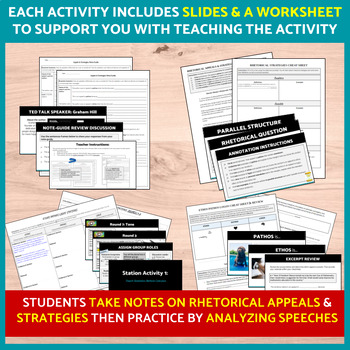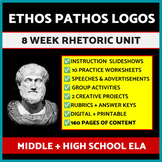7 Fun Ethos Pathos Logos Activities, Worksheets, Rhetoric Slideshow and Notes
- Google Drive™ folder

Also included in
- SAVE 25% OFF with this 8-week Ethos Pathos Logos Mega Bundle. Strengthen your middle and high school student’s rhetorical analysis, argumentation, communication, and persuasive writing skills with a variety of fun and engaging activities that teach argumentative writing. This bundle differs from otPrice $105.28Original Price $141.00Save $35.72
Description
This exciting bundle of ethos pathos logos activities will get your students moving around the room and collaborating with peers as they practice strengthening their rhetorical analysis skills. This bundle includes a week of Ethos Pathos Logos Activities that consist of review activities, practice activities, worksheets, and annotation guides. The included 70-page Slideshow supports you with teaching each activity. These ethos, pathos, and logos activities provide your students the opportunity to learn the art of rhetoric in fun and collaborative ways. Activities are engaging and student-centered. Throughout this mini-unit, students analyze 4 different speeches to practice identifying and analyzing ethos, pathos, and logos.
This bundle of ethos pathos logos activities is great for teachers who want their students to gain a stronger understanding of each rhetorical appeal through a variety of practice activities. During this mini-unit, students also practice working with rhetorical strategies such as anaphora, anecdote, parallel structure, rhetorical questions, and tone to strengthen their writing skills.
These ethos, pathos, and logos activities will take 5-7 class periods depending on your pacing. Within this unit, students analyze a series of engaging speeches and practice identifying ethos, pathos, and logos as well as other rhetorical strategies within each speech. During each activity, students are provided an ethos pathos logos worksheets or note-taking guide to practice working with each appeal.
What your students will love about these activities is that they are highly collaborative and make working with ethos, pathos, and logos fun and interactive. Students love the station rotation activities in this unit. My students love working in groups to analyze the various speeches in this unit, and the stations make the activities fun! Plus, these station activities provide students with a more exciting way to practice ethos pathos logos than a more traditional ethos pathos logos worksheet.
What this purchase includes:
- 70 visually engaging slides that guide students through each activity
- Ethos Pathos Logos Review Activity with a note-taking guide (printable)
- 3 Ted Talk Speeches with speech transcripts (printable)
- 3 Rhetorical Appeals and Strategies Worksheets that accompany Ted talks with blank one for any speech (printable)
- 2 Station Rotation Activities with 8 printable stations
- 2 Station Activity Worksheets (digital or printable)
- Rhetorical Strategies Review Activity with a note-taking guide (printable)
- 2004 National Convention Speech with annotation activity (printable)
- Blank Station Rotation Activity Slideshow to use with any speech
- Teacher notes throughout the slideshow including tips for success and step-by-step instruction (what to print what to assign on each day)
- Rubrics included
About Each Activity:
Activity 1: Review of Ethos Pathos Logos, Ted Talk & Station Rotation
The 70-page slideshow starts with a review of ethos, pathos, and logos that gives students a brief overview of Aristotle's rhetorical appeal. Students take notes on their printable note-taking guide as they review. After, students complete the first activity where they review a short and engaging Ted Talk to interpret the techniques and rhetorical strategies used by the speaker. Students answer discussion questions in their note-taking guide to practice analyzing the speech.
Afterward, students dive deeper by analyzing the transcript of the speech. Students do so by completing a collaborative station rotation activity in groups. Students practice finding examples of each appeal in their small groups and provide a rationale to prove their understanding. Your students will love moving around the room and working together with their peers. Rubric included.
Activity 2: Rhetorical Strategies Note-Guide
For the next lesson, students learn about the following rhetorical strategies: anaphora, anecdote, rhetorical question, and parallel structure. Students take notes as they review engaging examples of each appeal from the slideshow. The slides include short clips from movies and famous speeches to help students gain a better understanding of each rhetorical strategy. After reviewing each strategy, students practice creating examples of each rhetorical strategy in their note-taking guide. Students will use their note-taking guide and new understanding of rhetorical strategies to support them during the next activity.
Activity 3: National Convention Speech Annotation Practice Activity
Next, students review a National Convention Speech from 2004 and apply what they learned about rhetorical strategies from the previous lesson to their speech transcript. Students complete a partner annotating activity on their printable worksheet where they annotate examples of ethos, pathos, and logos in the speech as well as the examples of rhetorical strategies found in the speech. Rubrics included.
Activity 4: National Convention Speech Station Rotation Activity
Next, students complete another station rotation activity to further analyze the National Convention Speech with new group mates. For this activity, you print out the 8 stations and place them around the room. Students move to each station every 5-7 minutes and are provided instructions at each station that provide them the opportunity to practice analyzing ethos, pathos, and logos, as well as tone, and how the author uses various rhetorical strategies. Rubric included.
Activity 5 & 6: Analyzing Two Ted Talk Speeches and Practice Worksheet/ Note-Taking Guide
The next 2 ethos pathos logos activities include two short and engaging TED talks. Students complete a printable note-taking guide where they analyze each author's use of ethos, pathos, logos, as well as their use of different rhetorical strategies. By the end of these activities, your students will be masters at rhetorical analysis! You will enjoy these activities because students are guided to share their findings in group discussions and are provided with a lot of meaningful opportunities to collaborate with their peers. Rubrics included.
Bonus: Rhetorical Appeals & Strategies Blank Note-Taking Guide & Blank Station Activity
Also included is a blank printable note-taking guide that you can use with any Ted Talk or Speech. The guide asks students to determine the tone of a passage and also find examples of ethos, pathos, logos, parallel structure, anecdotes, rhetorical questions, etc. This is a great activity to complete throughout the year to provide your students with the opportunity to continue improving their rhetorical analysis skills. As well, there is also a blank station activity included that you can use with any speech or Ted Talk.
All products are made on Google Docs. and Google Slides, and editable to fit your classroom needs. Everything is ready to teach & ready to print.
Activities in this mini unit are intended for printable use. The station activities can be completed digitally or as a printout.
This purchase covers 1-2 weeks of Middle or High School ELA curriculum depending on your class pacing.
Please share how the activities work in your classroom! Your feedback is so valuable to me.
More from my Ethos Pathos Logos Unit...
My Ethos, Pathos, Logos Unit Bundle includes everything you need to teach a 6-week Rhetorical Analysis Unit. here are some activities from the bundle:
- Ethos Pathos Logos Practice Activity & Stations: This is a fun practice activity that gets students moving around the room!
- Ethos, Pathos, Logos Activities & Unit Guide 2: This is the second unit guide which includes 7 more practice activities to continue sharpening up ethos, pathos, logos skills while also incorporating rhetorical strategies into the lesson plans.
- Ethos Pathos Logos: Scavenger Hunt Project Activity: Students chart ethos, pathos, logos in their everyday lives.
- Ethos Pathos Logos Research Project: Digital Brochure: Students create a digital brochure about a topic of their choice where they create an argument and back their claims using Aristotle's 3 appeals.
Check-out more from my store!






